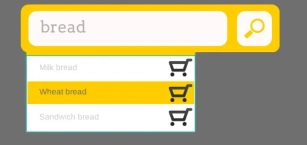- ProductsSearch and BrowseRecommendationsCustomer Engagement


Merchandising was an important function in brick-and-mortar stores. When merchandising moved online, real estate was the least of anyone's worries. Retailers slowly started to realize that wasn't the case.
Even though, theoretically, online real estate is unlimited, useful real estate is limited by how far shoppers are willing to scroll down.
And shoppers don't like scrolling.
Nielsen found that shoppers spend 80% of their time "above the fold,"; i.e., the space viewable by a shopper on one screen at a time, without having to scroll. Moreover, above-the-fold recommendations and promotions are 1.7 times more effective than those below the fold.
Therefore, merchandising effectively in this limited online real estate is critically important for successful online retailing.
Need for manual controls in merchandising
With the advent of artificial intelligence and machine learning, most eCommerce functions have been successfully automated. However, not all intelligent algorithms can replace real-world wisdom and insight. At least not yet.
This is especially true for merchandising. Effective merchandising lies at the intersection of the following two goals:
- Maximizing orders by showing products to shoppers they are most likely to buy
- Effectively managing business requirements by upselling/cross-selling products
But most automated solutions can optimize only the first goal. For instance, liquidating surplus inventory might involve grouping certain items to be sold for a lesser price than when bought separately. It might include giving away freebies and incentives or selling them for discounted purchases. Making such decisions cannot be the outcome of a number-driven formula (where automation excels). Instead, it requires the wisdom of someone who has extensive experience in the industry.
Business scenarios that require manual intervention
Brand promotions
It is not uncommon for retailers to sign contracts with brands to promote them on their sites. Often, brand promotions are carried out via banner ads within site at various places. This could be within the menu, on the homepage or category pages, or even right in the search box.
Brand promotions could also be subtle: boosting, pinning, and slotting certain brands to the topmost positions for a relevant category or shopper query are also common.
Manual intervention is necessary here to maximize the visibility and effectiveness of brand promotions.
Seasonal promotions
During events or holidays like Christmas, Valentine's Day, etc., promoting specific products associated with such holidays generates more revenue.
To maximize revenue, merchandisers must select which products (or combos) to promote or cross-sell during a particular season. This decision can be complicated even further by other factors.
For example, trending products for a particular season, say Spring, might differ from location to location. For instance, Minnesota might have a colder spring season than California. Fabric type is a crucial factor in generating more sales in this case. In such scenarios, merchandisers' real-world insights are less effective than automation tools.
New arrivals
On fast-selling eCommerce sites, new products are added almost daily or, in some cases, even hourly. Newly added products do not have any historical performance data; therefore, they need the wisdom of a seasoned merchandiser to ensure maximum visibility.
Inventory clearance
Often, businesses are left with excess inventory, the old stock they need to deal with. Merchandising for clearing inventory involves discounted sales, special promotions, and effective advertising. This requires manual decision-making by the merchandiser because clearance sales not only equate to discounted prices but also include other decisions like zeroing in on combos, positioning, etc.
Tools a good merchandising solution should provide
Campaign creation
Merchandisers may run several campaigns at once, depending on the objective of the promotion. Therefore, the system should allow merchandisers to create landing pages for various digital marketing campaigns without help from the IT team.
For instance, a merchandiser may want to create a landing page for an email campaign promoting products from a specific brand.
Boosting
This is particularly useful when merchandisers want to boost the visibility of a product or a set of products for a shopper query or a particular category.
Boosting artificially increases the relevance ranking of products that satisfy the added rule and moves them up in the display order.
Boosting is used in various scenarios: for subtle promotion of brands, increasing the visibility of new arrivals, etc.
Pinning
Pinning is used when a merchandiser wants to pin a specific product to a particular position. For example, new arrivals do not have a popularity score. So, to increase their visibility, the merchandising solution should allow the manual pinning of products to desired positions.
Slotting
Merchandisers use slotting to select various products in a specific category to position them in a consecutive range of slots based on a set of conditions.
For example, slotting might position inventory clearance at the top to garner more visibility.
Banners
Visual merchandising heavily rely on banners. Merchandisers should be able to create banners on the homepage, category pages, sub-menus, autosuggestions box, shopping carts, and so on, where shoppers are more likely to view them.
Filters
These come in handy when a merchandiser wants to showcase similar products to shoppers. For instance, during inventory clearance, the merchandiser may wish to direct shoppers to a filtered set of similar products grouped by their discount percentage.
Use manual merchandising along with automation to maximize revenue
Balancing automated and manual merchandising is a blend of art and science, and it significantly varies from business to business. Automate the merchandising actions you can to leverage the advantage machine learning algorithms offer, and use it in conjunction with manual merchandising that fits your business requirements. Explore the working of Unbxd's merchandising console and optimize your product performance!


